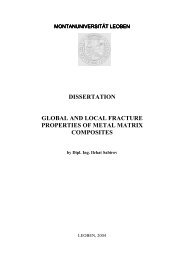1 - Erich Schmid Institute
1 - Erich Schmid Institute
1 - Erich Schmid Institute
Create successful ePaper yourself
Turn your PDF publications into a flip-book with our unique Google optimized e-Paper software.
1<br />
Summary<br />
teristics. Firstly, the stresses grow nearly exponentially from −0.81GP a at the surface<br />
to −3.39GP a at the interface. Secondly, the corresponding errors of the stresses in the<br />
individual sublayers or the standard deviations, respectively, range from 0.11GP a at the<br />
surface to 0.87GP a at the interface, which can be explained analyzing the deflection as<br />
a function of film thickness. The deflection does not change significantly with the film<br />
thickness in the region near the surface, but it shows a strong gradient near the interface.<br />
Here, the change in the magnitude of the errors in the sublayers is caused by the uncertainty<br />
in measuring the film or sublayer thickness, respectively because the influence of<br />
this error is much smaller near the surface than in the vicinity of the interface owing to<br />
the shape of the deflection versus film thickness curve.<br />
A further development of the ILR method is the three dimensional ion beam layer removal<br />
(3D-ILR) method presented in paper C. This technique allows the determination<br />
of spatial residual stress profiles in near-surface structures and is presented by investigating<br />
the residual stress field in and around the plastic zone resulting from a shallow<br />
scratch in the Ni film investigated in paper A.<br />
The 3D-ILR method provides two dimensional stress profiles from a number of parallel<br />
cross sectional cuts through a spatial stress profile. In each experiment, the stress component<br />
along the cantilever fabricated parallel to the edge is determined. The stresses<br />
perpendicular to the cantilever relax partially, depending on the cantilever width; a<br />
determination of these stresses would require the fabrication of another cantilever perpendicular<br />
to the specimen edge. The experimental and calculation procedure for the<br />
two-dimensional stress profiles is similar to the procedure of the basic ILR method.<br />
The experimental procedure starts with FIB cut performed at the edge of the specimen<br />
to obtain a plane view on the cross section of the scratched system. This cross section<br />
is divided into a number of a few microns wide sections. A cantilever is fabricated from<br />
this cross section in a way that it is located far away from the plastic zone and the ILR<br />
method is performed to obtain the depth profile of residual stresses. Now the cantilever<br />
is elongated by removing the substrate material in the section next to the cantilever,<br />
which leads to a change in the deflection. Then, the film thickness is reduced gradually<br />
in this new section and the stress distribution is calculated. This procedure of elongating<br />
the cantilever by the length of the adjacent section, removing the thin film gradually<br />
and measuring the corresponding deflection is repeated until the center of the scratch is<br />
reached.<br />
The calculated depth profiles of residual stresses as a function of the lateral position<br />
normal to the scratch shows a general trend: far away from the scratch, the depth profile<br />
of residual stresses exhibits a gradient growing from the surface towards the interface<br />
as described in paper A and an average stress of 460 ± 60MP a. This stress gradient<br />
decreases moving towards the center of the scratch, where finally the residual stresses are<br />
homogeneously distributed over the film thickness at a mean stress of −478 ± 91MP a.<br />
This example presents the ability of the 3D-ILR method to determine spatial stress<br />
profiles with a depth resolution on a nanoscale and a lateral resolution in the micron<br />
range.<br />
Besides the residual stress profiles, fracture toughness and strength of thin films are<br />
essential for the structural integrity and the lifetime of coated components. In paper D,<br />
28
















